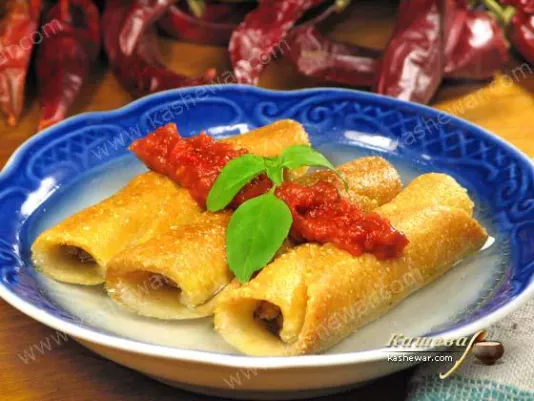Avocado Deep Fried
Deep-fried avocado - a recipe for Mexican cuisine, this recipe probably came as a surprise to some people.

Mexican cuisine is one of the most famous and influential in the world, combining deep roots from the pre-Columbian era with culinary innovations of the colonial period. It is based on traditional ingredients once used by the Aztecs, Maya, and other indigenous peoples: corn, chili, beans, tomatoes, avocado, squash, and cacao. After the arrival of the Spanish, ingredients like meat, rice, oil, onions, and garlic enriched the cuisine. Tortillas – thin flatbreads made from corn or wheat flour – play a key role and are served with fillings, sauces, or as a side. The heat of the dishes is achieved with dozens of chili varieties, each with its own character. Popular dishes such as tacos, enchiladas, nachos, mole, guacamole, and chilaquiles have become an integral part of global cuisine. At the same time, Mexican cuisine maintains a deep respect for traditions and rituals, serving as both everyday and festive food.
Mexican recipes impress with their variety and simplicity of preparation. Many are passed down orally within families, and some have survived since pre-Columbian times. Tacos take center stage – corn or wheat tortillas filled with meat, vegetables, legumes, and salsa. Enchiladas are made from tortillas wrapped around cheese or meat and topped with mole or salsa. Nachos are a popular snack where tortilla chips are layered with cheese, beans, jalapeños, meat, or guacamole. In southern regions, seafood dishes are common, such as shrimp cocktails or tuna tostadas. Desserts include flan, churros, sweet tamales, or pan de muerto baked for the Day of the Dead. Many Mexican recipes are adapted to modern lifestyles while remaining delicious and nutritious. They are easy to prepare at home and always bring delight.
Mexican cuisine developed through the interaction of many cultures. Before the Spanish arrived, local peoples had a sophisticated gastronomic system centered around corn, chili, and beans. With colonization came new ingredients – pork, beef, chicken, rice, wheat, cheese, and olive oil. The result was a unique fusion known as mestiza, combining European techniques with local products. Later waves of immigration – French, Lebanese, Caribbean – also influenced regional cuisines. For example, Mexican pan de sal rolls have French roots, and the popular taco al pastor has Middle Eastern origins. Mexican cuisine, as a product of long-term cultural exchange, retains its authenticity, embodying the spirit of its people and the history of the country on every plate.
Corn is the cornerstone of Mexican cuisine and is used in all forms: fresh kernels, flour, dough, and grits. It is the base for tortillas, tamales, atole, tostadas, porké, and many other dishes. Beans are equally important, providing protein and pairing well with meat or vegetables. Chili is the heart of flavor, and each region uses its own varieties: poblano, chipotle, ancho, habanero. Chili-based sauces – salsa, mole, pico de gallo – add depth to the dishes. Avocado is widely used in guacamole, side dishes, and even soups. Tomatoes, garlic, onions, cilantro, and lime are common aromatics. Mexican cuisine also includes elements of fermentation, as seen in mole or tangy sauces. Ingredients are not just combined but balanced among sweet, salty, sour, bitter, and umami. Every dish is a carefully crafted harmony of flavor, color, and texture.
Mexican cuisine is highly regionalized. In northern states, where cattle ranching thrives, beef dishes like asado, barbacoa, and burger tacos are popular. In the country’s center, classic tacos with various fillings, soups, enchiladas, and pork dishes dominate. Southern regions like Oaxaca and Chiapas are known for their use of chocolate, turkey, cheese, and complex mole sauces. The coasts offer a rich selection of seafood, including ceviche tostadas and shrimp soup. In Yucatán, Mayan traditions prevail, with ingredients like annatto, orange juice, and banana leaves. Dishes such as cochinita pibil or salbutes are unique to this part of Mexico. Each region has its own recipes and cooking methods, forming a culinary map worth exploring step by step.
In Mexico, food is not just a source of pleasure but a vital part of culture, rituals, and social bonds. Family gatherings, religious holidays, birthdays, and funerals are all marked by shared meals. Dishes are often prepared collectively, with each family member playing a role. Tamales, for example, are made in large batches before celebrations, bringing together multiple generations. The Day of the Dead includes special bread and offerings of the deceased's favorite foods placed on altars. Street food – tacos, elote, churros – is part of daily life and symbolizes community. Mexicans maintain respect for tradition, passing down recipes and techniques through generations. Food serves as a means of self-expression, national pride, and cultural continuity, making it central to the Mexican way of life.